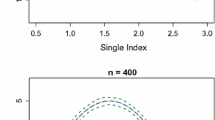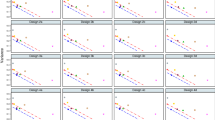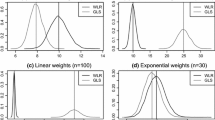Abstract
In this paper we present a way of conducting design of experiments by Multivariate Additive Partial Least-Squares Splines models, in short MAPLSS. In the framework of optimal experimental design based on small samples, in order to select the most informative MAPLSS model, we process an adaptive incremental selection of observations by a particular bootstrap procedure. Why MAPLSS models? Because they inherit the advantages of the PLS regression that permits to capture additively non-linear main effects and relevant interactions in the difficult framework of small samples. The effectiveness of this approach is illustrated on the reservoir simulator data used to forecast oil production.
Similar content being viewed by others
References
BUHLMANN, P. (2006), “Boosting for High-Dimensional Linear Models”, The Annals of Statistics, 34(2), 559–583.
BUHLMANN, P., and YU, B. (2003), “Boosting with the L2 Loss: Regression and Classification”, Journal of the American Statistical Association, 98, 324–339.
CHUNG, K.H., and LEE, S.M.S. (2001), “Optimal Bootstrap Sample Size in Construction of Percentile Confidence Bond”, Scandinavian Journal of Statistics, 28(1), 225–239.
DURAND, J.F., and SABATIER, R. (1997), “Additive Splines for Partial Least Squares Regression, Journal of the American Statistical Association”, 92(440), 1546–1554.
DURAND, J.F. (2001), “Local Polynomial Additive Regression Through PLS and Splines: PLSS”, Chemometrics and Intelligent Laboratory Systems, 58, 235–246.
DURAND, J.F. (2008), “La régression Partial Least-Squares boostée”, Revue MODULAD, 38, 63–86.
DURAND, J.F., and LOMBARDO, R. (2003), “Interaction Terms in Non Linear PLS via Additive Spline Transformations”, in Studies in Classification, Data Analysis and Knowledge Organisation, Between Data Science and Applied Data Analysis, Proceedings of the 26th Annual Conference of the Gesellschaft für Klassifikation e V., University of Mannheim, July 22-24, 2002, eds. M. Schader, W. Gaul, and M. Vichi, Berlin-Heidelberg: Springer, pp. 22–29.
EFRON, B., and TIBSHIRANI,R. (1993), An Introduction to the Bootstrap, London: Chapman and Hall.
FERAILLE, M., MANCEAU, E., ZABALZA-MEZGHANI, I., ROGGERO, F., HU,L.Y., and REIS, L.C. (2003), “Integration of Dynamic Data in a Mature Oil Field Reservoir Model to Reduce the Uncertainty on Production Forecasting”, in Proceedings AAPG Annual Meeting, 11-14 May 2003, Salt Lake City, Utah.
FARAJ, A., NOCAIRI, H., and CONSTANT, M. (2007), “Selection de modéle PLS par rééchantillonnage bootstrap”, in review.
FEDOROV, V.V. (1972), Theory of Optimal Experiments, New York: Academic Press.
FORINA, M., CASOLINO, C., and PIZARRO MILLAN, C. (1999), “Iterative Predictor Weighting (IPW) PLS: A Technique for the Elimination of Useless Predictors in Regression Problems”, Journal of Chemometrics, 13, 165–184.
GAUCHY, J.P., and CHAGNON, P. (2001), “Comparison of Selection Methods of Explanatory Variables in PLS Regression with Application to Manufacturing Process Data”, Chemometrics and Intelligent Laboratory Systems, 58, 171–193.
GILARDI, N., and FARAJ, A. (2004), “Design of Experiments by Committee of Neural Networks”, in IEEE International Joint Conference on Neural Networks, Budapest 25-29 July 2004, Hungary.
HASTIE, T., TIBSHIRANI, R., and FRIEDMAN, J. (2001), The Elements of Statistical Learning, Data Mining, Inference and Prediction (Series in Statistics), New York: Springer.
KROGH, A., and VEDELSBY, J. (1995), Neural Networks Ensembles, Cross Validation and Active Learning. Advances in Neural Information Processing Systems 7, Cambridge MA.
LAZRAQ, A., CLROUX, R., and GAUCHI, J.P. (2003), “Selecting Both Latent and Explanatory Variables in the PLS1 Regression Model”, Chemometrics and Intelligent Laboratory Systems, 66, 117-1-26.
LOMBARDO, R., DURAND, J.F., and DE VEAUX R.D. (2009), “Model Building in Multivariate Additive Partial Least-Squares Splines via the GCV Criterion”, Journal of Chemometrics, 23, 12, 605–617.
MITCHELL, T.J. (1974), “An Algorithm for the Construction of D-Optimal Experimental Designs”, Technometrics, 16, 2, 203–210.
SCHEIDT, C., ZABALZA-MEZGHANI ,I., FERAILLE ,M., GUARD, B., and COLLOMBIER, D. (2006), “Adaptive Experimental Design for Non-Linear Modeling - Application to Quantification of Risk for Real Field Production”, in Proceedings ECMOR X Amsterdam, pp. 4–7.
TENENHAUS, M. (1998), La Régression PLS, Thorie et Pratique, Paris: Éditons Technip.
WOLD, S., MARTENS, H., and WOLD, H. (1983), “The Multivariate Calibration Problem in Chemistry Solved by PLS Method”, in: Lecture Notes in Mathematics, Proceedings of the Conference on Matrix Pencils, eds. A. Ruhe and B. Kagstrom, Heidelberg: Springer-Verlag, pp. 286–293.
Author information
Authors and Affiliations
Corresponding author
Rights and permissions
About this article
Cite this article
Lombardo, R., Durand, JF. & Faraj, A. Iterative Design of Experiments by Non-Linear PLS Models. A Case Study: The Reservoir Simulator Data to Forecast Oil Production. J Classif 28, 113–125 (2011). https://doi.org/10.1007/s00357-011-9071-2
Published:
Issue Date:
DOI: https://doi.org/10.1007/s00357-011-9071-2




